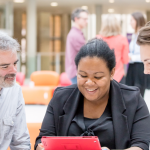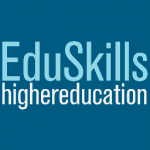Giving students power over their learning data
Universities are investing time and money in creating learning analytics systems, but Ed Foster of Nottingham Trent Universities says these systems are only as good to the support given to staff and students who use them.
Value me not my money: why students are key to good decision making
The notion of the student as a consumer is one that is gaining popularity. But NUS vice president (higher education) Megan Dunn says universities need to start seeing students as full members of their community who should play an active role in it, rather than customers, easily impressed by shiny new buildings.
Be better with digital, students tell staff in Jisc survey
Students have stated their frustration at staff's lack of training in - and inconsistent use of - technology in Jisc's digital student tracker report. The survey which involved 22,000 higher education students is one of the largest of its kind.
New classrooms for a new curriculum
As classrooms become more connected through students' use of their own devices in lectures and seminars, universities are responding in exciting ways. Gunter Saunders and Federica Oradini describe how the University of Westminster is embracing these changes by transforming their classrooms.
What we’ve learned from pedagogic podcasting
Academics at Birkbeck College have sought to take their teaching beyond the lecture room with a weekly podcast to support their British politics module. Dr Dermot Hodson, reader in political economy and Dr Ben Worthy, lecturer in politics outline the lessons from the initiative over the past two years.
Using apprenticeships to bring wider regional benefits
On the HEFCE blog, Sarah Tudor, director of business engagement services at Staffordshire University, explains how apprenticeships have given the university the opportunity to enhance employer relationships and address skills gaps.
How is the sector engaging students?
The sector is supporting student engagement and enhancing students’ learning experiences in a number of ways. Hefce's Ellie Clewlow describes some of the latest innovations.
From manual to automatic: developing learning analytics at Aston
After Aston University carried out a project to identify students at risk of withdrawal or non-progression, they realised they needed to move from manual analytics to a more comprehensive learning analytics system. Following a partnership with Jisc to develop such a system, they are already seeing the benefits, as James Moran explains.
Universities join forces to design learning analytics architecture for the sector
Universities wishing to raise achievement of all students were urged to consider adopting learning analytics in the Higher Education Commission's recent report ‘From Bricks to Clicks’. In this blogpost, Phil Richards says the sector is now also recognising learning analytics as a priority area and Jisc is working with universities deliver a national open architecture for this work.
From Bricks to Clicks – the potential of data and analytics in higher education
Big data and analytics are being used by businesses to have more understanding of their customers and products in order to spot opportunities and to become more efficient and more innovative. This report recommends that Universities UK, Jisc and HESA work together to develop a strategy for excellence and innovation in data management and analytics.












